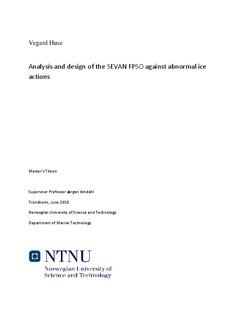| dc.contributor.author | Huse, Vegard | nb_NO |
| dc.date.accessioned | 2014-12-19T12:05:42Z | |
| dc.date.available | 2014-12-19T12:05:42Z | |
| dc.date.created | 2010-12-01 | nb_NO |
| dc.date.issued | 2010 | nb_NO |
| dc.identifier | 373638 | nb_NO |
| dc.identifier.uri | http://hdl.handle.net/11250/237763 | |
| dc.description.abstract | As the oil price is relative high, oil companies continue their quest for oil in new areas where it was supposed impossible earlier. 25 % of the world petroleum reserves are assumed to be in Arctic areas. In these areas ice contribute to significant engineering challenges. Ice conditions, emergency response, winterization and extreme low temperatures are some of the challenges that have to be address for design and operation purpose.
Ice is an interesting material for an engineer. The knowledge of ice mechanics and physics is essential for understanding how ice forces are developed and acts. The agreement in estimating of forces and development of ice loads have been over time been evaluated for the writing of new structural code. Structural layout proofs to be a significant factor in how ice is managed and therefore in reducing ice actions. However studies have showed that prediction of ice actions is hard to establish and therefore it is difficult to establish proper loading cases.
For designing a FPSO in the arctic waters, the classification criteria for floating units need to be complied with. The DNV rules for offshore structure refer to the class rules for ship with additional ice strengthening class. The ISO (International Organization for Standardization) the world's largest developer and publisher of International Standards have issued a draft for a design code for Arctic offshore structures. These two rules and codes have been compared in connection with local structural arrangement.
For arctic structures, two design checks ELIE and ALIE are required. These design checks are less established. ELIE ice checks have a return period of one hundred year (10-2) and ALIE one thousand year (10-4). The SEVAN-FPU ice is designed for handling level ice up to 3 m according the DNV Polar 30 Class Notation. Structures are according to the codes required to withstand the ice actions from ELIE within the elastic region. ALIE action will involve plastic damage, but the requirement is to maintain structural integrity to survive a ULIE check. The master thesis purpose is to determine ELIE and ALIE. The ELIE and ALIE are clearly depended on local field data which makes it a challenge in estimations.
The ELIE design load for the Sevan FPU-ice is based on a pressure-area equation for massive ice feature. The pressure-area equation is based on empirical data measurement from several field programs. The load area for a plate design is assumed to be the whole plate area, while for the stiffener design 80% of the plate height times four stiffener spacing. The ELIE pressure is respectively 5.11 MPa and 2.37 MPa.
For arctic structures, iceberg is the governing factor for ALIE. Designing for an impact of a large iceberg in 100 or 10 000 years storm may be impossible due to the massive energy involved. Sevan FPU-ice is designed with possibility of disconnecting. This may reduced the ALIE load, however the possibility of failure in disconnecting should be included in ALIE. In estimation of iceberg impact, kinetic energy is the load applied for calculations. Structural resistance for impact is measured in energy dissipated in strain before fracture. The plastic strain gives the dominating dissipated energy and elastic strain is in a small magnitude. By equating kinetic energy applied and strain energy dissipated before fracture can be seen as what the structure can withstand.
ABAQUS standard has been applied for analyzing different structural layout with the intentional structural layout for SEVAN- FPU-ice as a basis. A non linear finite element analysis is preformed to investigate structural capacity and the energy dissipated in plastic strain in order to check for ELIE and ALIE. The model has been created using the ABAQUS CAE.
The ELIE design loads for plate and stiffener design are applied for the ABAQUS for the intentional structural layout. Both plate and stiffener design check was applied in the elastic region.
Six different models were made with different stiffener profile. Plate and stiffener spacing were hold constant with the structural layout given from Sevan. For finding the ultimate strength of the, a plate patch load was applied with three different load intensity. The load intensity was found in the using the same pressure area curve as for the ELIE design load. The loads were scaled up to an assumed strain level beyond critical strain. The result showed that a T-bar stiffener withstands the pressure loads significant better. The results from the analysis should be handled with care. In particular the boundary conditions should be evaluated further. The results should be verified by more extensive use of finite element programs. | nb_NO |
| dc.language | eng | nb_NO |
| dc.publisher | Norges teknisk-naturvitenskapelige universitet, Fakultet for ingeniørvitenskap og teknologi, Institutt for marin teknikk | nb_NO |
| dc.title | Analysis and design of the SEVAN FPSO against abnormal ice actions | nb_NO |
| dc.type | Master thesis | nb_NO |
| dc.contributor.department | Norges teknisk-naturvitenskapelige universitet, Fakultet for ingeniørvitenskap og teknologi, Institutt for marin teknikk | nb_NO |
